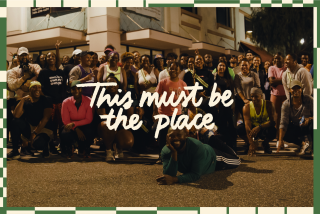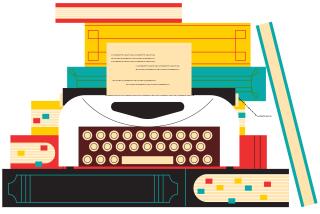Author brings cities’ character to vivid life
As a longtime political correspondent for the New York Times, where he is now associate editor, R.W. Apple Jr. visited and revisited cities all over the country. Not just a political animal, this journalist loves food (plain and fancy), architecture (historic and contemporary) and music (popular and classical, especially opera). So it’s no wonder, as we learn from his introduction to this book, that people about to visit a city often ask his recommendations on hotels, restaurants and noteworthy attractions.
“Apple’s America,” its author tells us, grew out of a series of monthly articles written for the New York Times starting in 1997 and ending in 2000. Writing for a New York audience, Apple decided to give the Big Apple a skip, but his roster of 40 “great” cities includes the 20 largest after New York, along with smaller places he just happens to like.
The contents are arranged (roughly) from east to west, beginning with Boston and concluding with Honolulu. Also featured are three Canadian cities -- Toronto, Montreal and Vancouver, the last of which, in Apple’s opinion, has “the best collection of Asian restaurants in North America.” Metropolitan areas around bodies of water -- Tampa Bay and the Hampton Roads region of Virginia -- intrigue him, too. Included, of course, are most of the usual tourist destinations -- Las Vegas, Miami, New Orleans, Los Angeles, San Francisco, Washington, D.C. -- but we’re also offered a closer look at less glamorous towns such as Buffalo, which Apple describes as a city with “an even longer history of architectural distinction than Chicago.” “Like a dowager in decline,” he writes, “Buffalo still has good bones to remind people of her more prosperous and glamorous days.”
Compared with other guidebooks, many of which feature extensive coverage of hotels and restaurants, detailed maps and useful tips for getting around, “Apple’s America,” it must be said, falls short. The maps are small, vague and skimpy; the travel tips scant; and only a few inns and eateries are listed for each city. (Apple generally commends the Four Seasons or the Ritz-Carlton, and in L.A., it’s the exclusive quartet of the Hotel Bel-Air, the Peninsula, Casa del Mar and Raffles L’Ermitage. He’s not the man to go to for the scoop on less expensive hostelries.)
“Apple’s America” is less a nuts-and-bolts guidebook to consult on the practical aspects of your trip than a book to read as background. What makes it special is the author’s uncommon knowledge of the cities and their histories. Evocative and insightful, his essays reveal the distinctive features of cities wrongly assumed to be featureless, from his salute to the vibrant spirit of Kansas City (the one in Missouri) to his portrait of a place known for little more than its brews: “The city has saved the best of its past. ‘Those old Germans,’ a Milwaukee friend of mine says, ‘were too frugal to tear anything down, thank God’.... Milwaukee people, like those in Hamburg, are compulsively orderly; anyone who doesn’t keep a neat house and a trim lawn is treated as a menace to society.”
Adept as he is at focusing on an area’s appealing qualities, Apple doesn’t look at cities through rose-tinted spectacles. Serious problems such as crime, urban sprawl, pollution, unemployment and housing shortages are frankly discussed. After mentioning the burgeoning of hotels and trendy eateries in Philadelphia, he quotes a question raised by a journalist at the Philadelphia Inquirer: “Can we live off this culture-dining-service boom, or do we need more lunch-bucket jobs to keep the whole thing going?” (A question that applies not only to Philadelphia.)
Apple’s political savvy adds dimension to his cityscapes and enables him to pay tribute to mayors who, in his estimation, are making cities work. One he singles out is Joseph P. Riley Jr., Charleston, S.C., mayor since 1975 and responsible, according to Apple, for turning “a proud but rotting relic into a model modern city.” Riley’s attention to housing, jobs and zoning laws safeguarding the quality of life have contributed to Charleston’s success. And, as one old-timer tells Apple: “I’d bet my life that he’s never stolen a dollar or cheated a soul.”
Naturally, the first city I looked up was Los Angeles. Apple’s portrait is full of the predictable cliches about Hollywood, mudslides, earthquakes, plastic surgery and vapidity. But he also draws attention to L.A.’s cultural and intellectual life, its museums, universities, music and architecture. Reading an outsider’s take on the place where one lives is bound to highlight any shortcomings in the visitor’s account. Yes, we have smog, but efforts to control emissions have improved the air quality from what it was half a century back, despite huge growth in the interim. Apple has, however, noticed the lovely scent that pervades our atmosphere on non-smoggy days throughout late winter and spring, attributing it to hibiscus, oleander and jasmine. He’s right about jasmine, but the first two are not very odiferous. The fragrance, in fact, comes mainly from Victorian box and a plethora of citrus blossoms.
Merle Rubin is a regular contributor to Book Review.
More to Read
Sign up for The Wild
We’ll help you find the best places to hike, bike and run, as well as the perfect silent spots for meditation and yoga.
You may occasionally receive promotional content from the Los Angeles Times.






